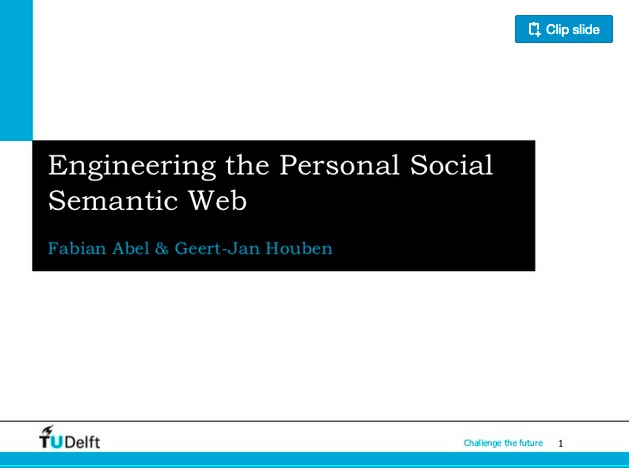About
In this tutorial, we discuss challenges and solutions for engineering the Personal Social Semantic Web, a Web where user modeling and personalization is featured across system boundaries. Therefore, we learn user modeling and personalization techniques for Social Web systems. We dive into engineering aspects of social tagging and micro-blogging services and examine appropriate modeling and mining techniques for these systems. We discuss Semantic Web and Linked Data principles that allow for linkage and alignment of distributed user data and show how system engineers can exploit the Social Semantic Web to personalize user experiences.
Presenters:
 |
Geert-Jan Houben @gjhouben |
 |
Fabian Abel @fabianabel |
TU Delft
Slides
Slides presented at ICWE:
View more presentations from Web Information Systems, TU Delft.
Slides: tutorial-slides.pptx
Structure:
- Introduction: UMAP
- User Modeling
- Adaptation
- Personalization
- Evaluation of UMAP Systems
- UMAP in Social Web Systems
- UMAP in Social Tagging Systems
- UMAP across Social Web systems
- Engineering UMAP on the Social Semantic Web
- Towards the Personal Web
- Exploiting Microblogging Activities for Personalizing the Social Web
Pointers
Semantic Enrichment, Linkage and Alignment:
- OpenCalais service (topic detection, (named) entity extraction)
- DBpedia Spotlight service (detects (and disambiguate) DBpedia resources in texts)
- Weka (data mining software)
- LingPipe (NLP tool for entity extraction, sentiment analysis)
- GATE (NLP framework)
- SILK (Link Discovery Framework for the Web of Data)
- Alignment API (Java library for discovering, storing and sharing alignments)
- Semantic Web Pipes (engine and graphical user interface for mashing up Semantic Web data)
- RDF Gears (extends Semantic Web pipes)
- Linked Data
Semantic Web vocabularies
- Friend-Of-A-Friend (FOAF) vocabulary
- Weighted Interest Vocabulary
- SIOC (linking online communities)
- Tag ontology (modeling tagging activities)
- MOAT ontology (meaning of a tag)
- Linked Open Vocabularies (LOV) (overview on vocabularies)
Towards the Personal Web:
- TweetUM (user modeling and personalization based on Twitter)
- PersWeb (Personal Web activities of the Web Information Systems group)
References
1. Introduction: UMAP
- (Baeza-Yates and Ribeiro-Neto 1999) R. A. Baeza-Yates and B. Ribeiro-Neto. Modern Information Retrieval. Addison- Wesley Longman Publishing Co., Inc., Boston, MA, USA, 1999.
- (Brusilovsky 2001) P. Brusilovsky. Adaptive hypermedia. In User Modeling and User-Adapted Interaction (UMUAI), 11(1/2):87-110, 2001.
- (De Bra et al. 1999) P. De Bra, G.J. Houben, H. Wu. AHAM: A Dexter-based reference model for adaptive hypermedia. In Proc. ACM Hypertext, pages 147-156. ACM Press, 1999.
- (Geisser 1975) S. Geisser. The predictive sample reuse method with applications. In Journal of the American Statistical Association, pages 320–328. American Statistical Association, June 1975.
- (Jameson 2003) A. Jameson. Adaptive interfaces and agents. The HCI handbook: fundamentals, evolving technologies and emerging applications, pages 305–330, 2003.
- (Sarwar et al. 2010) Badrul Sarwar, George Karypis, Joseph Konstan, and John Riedl: Item-based Collaborative Filtering Recommendation Algorithms. WWW 2010
2. UMAP in Social Web systems:
- (Abel et al. 2010) F. Abel, M. Baldoni, C. Baroglio, N. Henze, R. Kawase, D. Krause, and V. Patti. Leveraging search and content exploration by exploiting context in folksonomy systems. In D. Cunliffe and D. Tudhope, editors, New Review of Hypermedia and Multimedia: Web Science, volume 16, pages 33–70. Taylor & Francis, April 2010.
- (Abel et al. 2009) F. Abel, N. Henze, D. Krause, and M. Kriesell. On the effect of group structures on ranking strategies in folksonomies. In R. Baeza-Yates and I. King, editors, Weaving Services and People on the World Wide Web, pages 275–300. Springer, July 2009.
- (Bao et al. 2007) S. Bao, G. Xue, X. Wu, Y. Yu, B. Fei, and Z. Su. Optimizing Web Search using Social Annotations. In Proc. of 16th Int. World Wide Web Conference (WWW ’07), pages 501–510. ACM Press, 2007.
- (Firan et al. 2007) C. S. Firan, W. Nejdl, and R. Paiu. The Benefit of Using Tag-based Profiles. LA-WEB 2007
- (Heymann et al. 2008) P. Heymann, D. Ramage, and H. Garcia-Molina. Social tag prediction. SIGIR 2008
- (Hotho et al. 2006) A. Hotho, R. Jaeschke, C. Schmitz, and G. Stumme. Information retrieval in folksonomies: Search and ranking. In Proc. ESWC, volume 4011 of LNCS, pages 411–426, Budva, Montenegro, 2006. Springer.
- (Jaeschke et al. 2007) R. Jaeschke, L. B. Marinho, A. Hotho, L. Schmidt-Thieme, and G. Stumme. Tag recommendations in folksonomies. PKDD 2007
- (Jeh and Widom 2002) G. Jeh and J. Widom. SimRank: A Measure of Structural-Context Similarity. In Proceedings of KDD ’02, pages 538–543, New York, NY, USA, 2002. ACM.
- (Kleinberg 1999) J. M. Kleinberg. Authoritative sources in a hyperlinked environment. Journal of the ACM, 46(5):604–632, 1999.
- (Krestel et al. 2009) R. Krestel, P. Fankhauser, and W. Nejdl. Latent Dirichlet Allocation for Tag Recommendation. RecSys 2009
- (Mayfield 2006) R. Mayfield. Power-law of participation. April 2006.
- (Marlow et al. 2006) C. Marlow, M. Naaman, D. Boyd, and M. Davis. HT06, tagging paper, taxonomy, flickr, academic article, to read. In Proc. of the 17th Conf. on Hypertext and Hypermedia, pages 31–40. ACM Press, 2006.
- (Michlmayr et al. 2007) E. Michlmayr, S. Cayzer, and P. Shabajee. Add-A-Tag: Learning Adaptive User Profiles from Bookmark Collections. In Proc. of the 1st Int. Conf. on Weblogs and Social Media (ICWSM), 2007
- (Rendle et al. 2009) S. Rendle, L. Balby Marinho, A. Nanopoulos, and L. Schmidt-Thieme. Learning optimal ranking with tensor factorization for tag recommendation. KDD 2009
- (Rendle and Schmidt-Thieme 2010) S. Rendle and L. Schmidt-Thieme. Pairwise interaction tensor factorization for personalized tag recommendation. WSDM 2010
- (Sen et al. 2009) S. Sen, J. Vig, and J. Riedl. Tagommenders: connecting users to items through tags. WWW 2009
- (Sigurbjoernsson and van Zwol 2008) B. Sigurbjoernsson and R. van Zwol. Flickr tag recommendation based on collective knowledge. WWW 2008
- (Vander Wal 2005) T. Vander Wal. Explaining and showing broad and narrow folksonomies. 2005
- (Wu et al. 2006) H. Wu, M. Zubair, and K. Maly. Harvesting social knowledge from folksonomies. In Proceedings of the seventeenth conference on Hypertext and hypermedia (HYPERTEXT ’06), pages 111–114, New York, NY, USA, 2006. ACM Press.
- (Yin et al. 2010) D. Yin, Z. Xue, L. Hong, and B. D. Davison. A probabilistic model for personalized tag prediction. KDD 2010
3. Engineering the Personal Social Semantic Web:
- (Abel et al. 2011) F. Abel, E. Herder, G.-J. Houben, N. Henze, D. Krause. Cross-system User Modeling and Personalization on the Social Web. In P. Brusilovski, D. Chin (eds.): User Modeling and User-Adapted Interaction (UMUAI), Special Issue on Personalization in Social Web Systems, 2011
- (Abel et al. 2011b) Fabian Abel, Qi Gao, Geert-Jan Houben, Ke Tao. Semantic Enrichment of Twitter Posts for User Profile Construction on the Social Web. ESWC 2011
- (Berners-Lee 2007) T. Berners-Lee. Linked Data - design issues. W3C, May 2007.
- (Carmagnola and Cena 2009) Carmagnola, F., and Cena, F.: User identification for cross- system personalisation. Information Sciences: an International Journal 179(1-2):16–32. 2009
- (Iofciu et al. 2011) T. Iofciu, P. Fankhauser, F. Abel, K. Bischoff. Identifying Users Across Social Tagging Systems. In Proceedings of International Conference on Weblogs and Social Media (ICWSM), Barcelona, Spain, July 2011
- (Kwak et al. 2010) Kwak, H., Lee, C., Park, H., Moon, S.: What is twitter, a social network or a news media? In: Proc. of the 19th Int. Conf. on World Wide Web (WWW), New York, NY, USA, ACM (2010) 591–600
- (Mehta 2009) B. Mehta. Cross System Personalization: Enabling personalization across multiple systems. VDM Verlag, Saarbruecken, Germany, 2009.
- (Szomszor et al. 2008) Szomszor, M.; Cantador, I.; and Alani, H. 2008. Correlating user profiles from multiple folksonomies. In Proc. Hypertext, 33–42.
- (Vosecky et al. 2009) Vosecky, J.; Hong, D.; and Shen, V. Y. 2009. User identification across multiple social networks. In Int. Conference on Networked Digital Technologies (NDT ’09), 360 –365.
Conferences and Journals
Conferences and journals that are - in addition to ICWE - relevant for the topics discussed in this tutorial:
- UMAP conference series (UMAP '11) joins the former conferences AH (Adaptive Hypermedia) and UM (User Modeling)
- UMUAI journal
- Semantic Web: ISWC and ESWC conference; Journal of Web Semantics and Semantic Web Journal
- The usual suspect: WWW
- (Past) related workshops: SDoW, UWeb 2011, SPOT, LUPAS 2010
Datasets
- Tag recommendation challenge: http://www.kde.cs.uni-kassel.de/ws/dc09/dataset/
- List of social tagging datasets by Markus Strohmaier: http://kmi.tugraz.at/staff/markus/datasets/
- Twitter dataset by Kwak et al.: http://an.kaist.ac.kr/traces/WWW2010.html
- Twitter dataset for user modeling problems: http://wis.ewi.tudelft.nl/tweetum/#datasets
- Social Networking datasets by Jure Leskovec: http://snap.stanford.edu/data/


